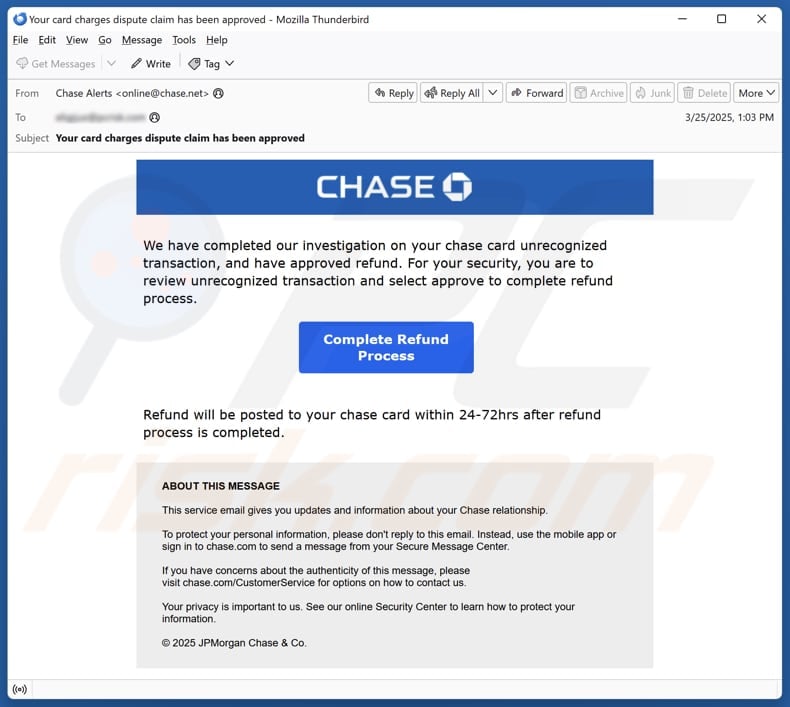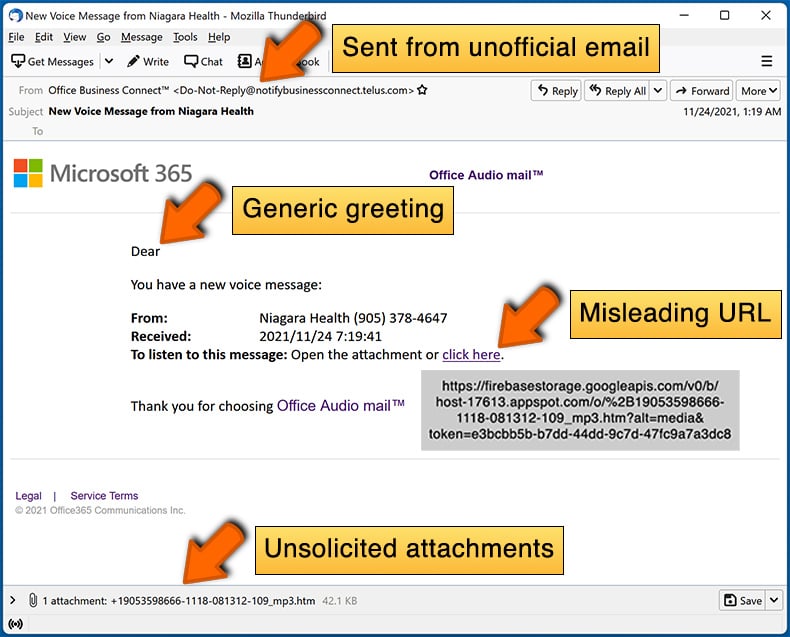How to spot scams like "Chase - Refund Process"
Phishing/ScamAlso Known As: Fake Chase - Refund Process email notification
Get free scan and check if your device is infected.
Remove it nowTo use full-featured product, you have to purchase a license for Combo Cleaner. Seven days free trial available. Combo Cleaner is owned and operated by RCS LT, the parent company of PCRisk.com.
What is the fake "Chase - Refund Process" email?
This is a phishing email designed to appear as if it is notifying the recipient about an approved dispute claim for charges on their credit card. Scammers utilize this scam email to deceive recipients into entering personal details on a fake web page. This email should be ignored.

More about the "Chase - Refund Process" scam email
The email is disguised as a notification from Chase and claims that an investigation into an unrecognized transaction on the recipient's Chase card has been completed, and a refund has been approved. It instructs the recipient to review the transaction through the "Complete Refund Process" button (link).
While we examined the email, we found that the provided website was down. However, there is a high chance that the provided link was supposed to open a fake Chase bank login website intended to steal login credentials. With this information, they could steal money, conduct fraudulent transactions, and obtain personal information such as names, addresses, and credit card details.
The consequences of falling for this phishing scam can include financial loss and identity theft. Thus, it is highly advisable to inspect emails and ensure they are legitimate before disclosing personal information, clicking links, or opening attachments.
| Name | Chase - Refund Process Email Scam |
| Threat Type | Phishing, Scam, Social Engineering, Fraud |
| Fake Claim | Your card charges dispute claim has been approved |
| Related Domain | redutech[.]org |
| Detection Names | alphaMountain.ai (Malicious), Combo Cleaner (Malware), CRDF (Malicious), Fortinet (Phishing), Sophos (Malware), Full List Of Detections (VirusTotal) |
| Disguise | Notification from Chase bank |
| Symptoms | Unauthorized online purchases, changed online account passwords, identity theft. |
| Distribution methods | Deceptive emails, fake websites. |
| Damage | Loss of sensitive private information, monetary loss, identity theft. |
| Malware Removal (Windows) |
To eliminate possible malware infections, scan your computer with legitimate antivirus software. Our security researchers recommend using Combo Cleaner. Download Combo CleanerTo use full-featured product, you have to purchase a license for Combo Cleaner. 7 days free trial available. Combo Cleaner is owned and operated by RCS LT, the parent company of PCRisk.com. |
Similar scam emails in general
Overall, these emails are designed to deceive recipients into revealing personal information or performing other actions. They often appear as legitimate, urgent notices or similar messages from legitimate companies, organizations, or other entities. It is essential to be cautious of unexpected messages, especially those containing links or attachments.
Examples of scam emails are "Two-Factor Authentication Activation Email Scam", "VoxFlowG USDT Airdrop Email Scam", and "Business Proposal Meeting Email Scam". Fraudsters can use such emails not only to extract personal information but also to deliver malware.
How do spam campaigns infect computers?
Cybercriminals who use email to deceive users into infecting their computers send harmful attachments or links. Some files, like executables, release malware as soon as they are opened, while others, such as Office documents, require the user to enable macros for the infection to occur. More examples of files used to deliver malware are PDFs, archives, script files, and ISO images.
Malicious links in emails may automatically start downloads or lead to fraudulent websites that trick users into manually executing malware. In both cases, computers cannot be infected via email without users opening malicious files or links found in fraudulent messages.
How to avoid installation of malware?
Always reject notification requests from dubious sites, keep your operating system and apps up to date, and avoid clicking on ads, pop-ups, or buttons on suspicious websites. Perform regular scans with a trusted security tool, and only download software (and files) from reputable sources, such as official pages or app stores.
Be cautious with unsolicited or irrelevant emails from unknown senders, especially those containing links or attachments. If you have already opened malicious attachments, we recommend running a scan with Combo Cleaner Antivirus for Windows to automatically eliminate infiltrated malware.
Text presented in the "Chase - Refund Process" email letter:
Subject: Your card charges dispute claim has been approved
Chase
We have completed our investigation on your chase card unrecognized transaction, and have approved refund. For your security, you are to review unrecognized transaction and select approve to complete refund process.
Complete Refund Process
Refund will be posted to your chase card within 24-72hrs after refund process is completed.
About This MessageThis service email gives you updates and information about your Chase relationship.
To protect your personal information, please don't reply to this email. Instead, use the mobile app or sign in to chase.com to send a message from your Secure Message Center.
If you have concerns about the authenticity of this message, please visit chase.com/CustomerService for options on how to contact us.
Your privacy is important to us. See our online Security Center to learn how to protect your information.
© 2025 JPMorgan Chase & Co.
Instant automatic malware removal:
Manual threat removal might be a lengthy and complicated process that requires advanced IT skills. Combo Cleaner is a professional automatic malware removal tool that is recommended to get rid of malware. Download it by clicking the button below:
DOWNLOAD Combo CleanerBy downloading any software listed on this website you agree to our Privacy Policy and Terms of Use. To use full-featured product, you have to purchase a license for Combo Cleaner. 7 days free trial available. Combo Cleaner is owned and operated by RCS LT, the parent company of PCRisk.com.
Quick menu:
- What is Fake Chase - Refund Process email notification?
- Types of malicious emails.
- How to spot a malicious email?
- What to do if you fell for an email scam?
Types of malicious emails:
![]() Phishing Emails
Phishing Emails
Most commonly, cybercriminals use deceptive emails to trick Internet users into giving away their sensitive private information, for example, login information for various online services, email accounts, or online banking information.
Such attacks are called phishing. In a phishing attack, cybercriminals usually send an email message with some popular service logo (for example, Microsoft, DHL, Amazon, Netflix), create urgency (wrong shipping address, expired password, etc.), and place a link which they hope their potential victims will click on.
After clicking the link presented in such email message, victims are redirected to a fake website that looks identical or extremely similar to the original one. Victims are then asked to enter their password, credit card details, or some other information that gets stolen by cybercriminals.
![]() Emails with Malicious Attachments
Emails with Malicious Attachments
Another popular attack vector is email spam with malicious attachments that infect users' computers with malware. Malicious attachments usually carry trojans that are capable of stealing passwords, banking information, and other sensitive information.
In such attacks, cybercriminals' main goal is to trick their potential victims into opening an infected email attachment. To achieve this goal, email messages usually talk about recently received invoices, faxes, or voice messages.
If a potential victim falls for the lure and opens the attachment, their computers get infected, and cybercriminals can collect a lot of sensitive information.
While it's a more complicated method to steal personal information (spam filters and antivirus programs usually detect such attempts), if successful, cybercriminals can get a much wider array of data and can collect information for a long period of time.
![]() Sextortion Emails
Sextortion Emails
This is a type of phishing. In this case, users receive an email claiming that a cybercriminal could access the webcam of the potential victim and has a video recording of one's masturbation.
To get rid of the video, victims are asked to pay a ransom (usually using Bitcoin or another cryptocurrency). Nevertheless, all of these claims are false - users who receive such emails should ignore and delete them.
How to spot a malicious email?
While cyber criminals try to make their lure emails look trustworthy, here are some things that you should look for when trying to spot a phishing email:
- Check the sender's ("from") email address: Hover your mouse over the "from" address and check if it's legitimate. For example, if you received an email from Microsoft, be sure to check if the email address is @microsoft.com and not something suspicious like @m1crosoft.com, @microsfot.com, @account-security-noreply.com, etc.
- Check for generic greetings: If the greeting in the email is "Dear user", "Dear @youremail.com", "Dear valued customer", this should raise suspiciousness. Most commonly, companies call you by your name. Lack of this information could signal a phishing attempt.
- Check the links in the email: Hover your mouse over the link presented in the email, if the link that appears seems suspicious, don't click it. For example, if you received an email from Microsoft and the link in the email shows that it will go to firebasestorage.googleapis.com/v0... you shouldn't trust it. It's best not to click any links in the emails but to visit the company website that sent you the email in the first place.
- Don't blindly trust email attachments: Most commonly, legitimate companies will ask you to log in to their website and to view any documents there; if you received an email with an attachment, it's a good idea to scan it with an antivirus application. Infected email attachments are a common attack vector used by cybercriminals.
To minimise the risk of opening phishing and malicious emails we recommend using Combo Cleaner Antivirus for Windows.
Example of a spam email:

What to do if you fell for an email scam?
- If you clicked on a link in a phishing email and entered your password - be sure to change your password as soon as possible. Usually, cybercriminals collect stolen credentials and then sell them to other groups that use them for malicious purposes. If you change your password in a timely manner, there's a chance that criminals won't have enough time to do any damage.
- If you entered your credit card information - contact your bank as soon as possible and explain the situation. There's a good chance that you will need to cancel your compromised credit card and get a new one.
- If you see any signs of identity theft - you should immediately contact the Federal Trade Commission. This institution will collect information about your situation and create a personal recovery plan.
- If you opened a malicious attachment - your computer is probably infected, you should scan it with a reputable antivirus application. For this purpose, we recommend using Combo Cleaner Antivirus for Windows.
- Help other Internet users - report phishing emails to Anti-Phishing Working Group, FBI’s Internet Crime Complaint Center, National Fraud Information Center and U.S. Department of Justice.
Frequently Asked Questions (FAQ)
Why did I receive a scam email?
Usually, scammers send the same email to a large number of recipients, and these emails are generic and lack names or other information about recipients.
I have provided my personal information when tricked by a scam email, what should I do?
If you have provided your login credentials to scammers, change your passwords right away. If you have disclosed sensitive personal information, such as credit card details or ID numbers, reach out to the relevant authorities immediately.
I have downloaded and opened a malicious file attached to an email, is my computer infected?
If the file was an executable, your system is likely infected. However, if it was a document (such as a .pdf, .doc, or similar), you might have avoided infection, as opening these files does not always trigger malware.
I have read an email but did not open the attachment, is my computer infected?
While opening an email is generally safe, clicking on links or opening attachments in suspicious emails can lead to malware execution.
Will Combo Cleaner remove malware infections that were present in email attachment?
Combo Cleaner is capable of detecting and removing most recognized malware. However, since sophisticated malware can sometimes hide deep within the system, it is advised to run a full system scan to ensure all threats are found and removed.
Share:

Tomas Meskauskas
Expert security researcher, professional malware analyst
I am passionate about computer security and technology. I have an experience of over 10 years working in various companies related to computer technical issue solving and Internet security. I have been working as an author and editor for pcrisk.com since 2010. Follow me on Twitter and LinkedIn to stay informed about the latest online security threats.
PCrisk security portal is brought by a company RCS LT.
Joined forces of security researchers help educate computer users about the latest online security threats. More information about the company RCS LT.
Our malware removal guides are free. However, if you want to support us you can send us a donation.
DonatePCrisk security portal is brought by a company RCS LT.
Joined forces of security researchers help educate computer users about the latest online security threats. More information about the company RCS LT.
Our malware removal guides are free. However, if you want to support us you can send us a donation.
Donate
▼ Show Discussion